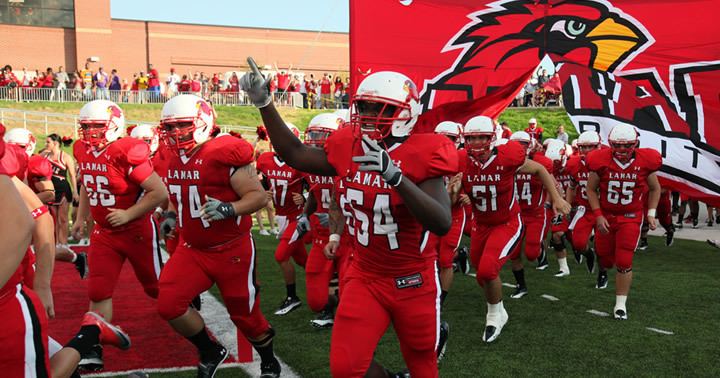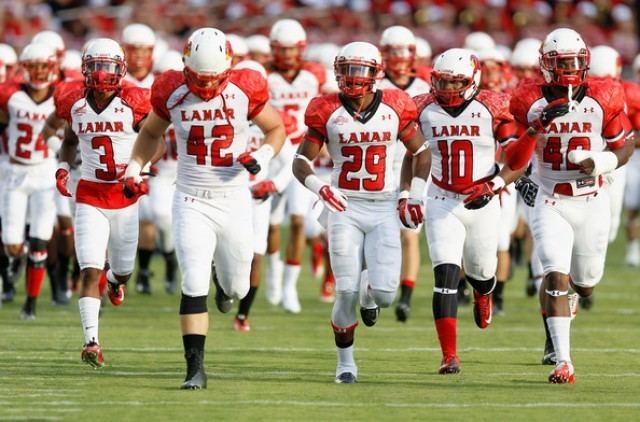First season 1923 Seating capacity 16,000 Head coach Mike Schultz Division Division I (NCAA) Mascot Cardinal | Athletic director Jason Henderson Field surface Hellas Matrix Turf Arena/Stadium Provost Umphrey Stadium Conference Southland Conference Colors Red, White | |
 | ||
Stadiums Provost Umphrey Stadium
(1964–present)
South Park High School "Greenie Stadium"
(c. 1923–1963) Field W. S. Bud Leonard Field Rivals McNeese State Cowboys football, Texas–Arlington Mavericks football | ||
2012 lamar cardinals football team
The Lamar Cardinals football program represents Lamar University in college football at the NCAA Division I Football Championship Subdivision (formerly Division I-AA) level. The Cardinals are members of the Southland Conference and play their home games in the 16,000 seat Provost Umphrey Stadium. As of December 22, 2016 The team's head coach is Mike Schultz.
Contents
- 2012 lamar cardinals football team
- The Early years
- Disbandment and reintroduction
- Division history
- Seasons
- Bowl history
- Highest attendance
- Yearly attendance
- McNeese State Cowboys
- LouisianaLafayette Ragin Cajuns
- References

The Early years

From its inception as South Park Junior College in 1923, football was a part of Lamar's history. It was discontinued in 1928 because of a lack of common opponents but was revived again in 1932 by the renamed Lamar College. Coach John Gray led his charges to records of 8–1 that season and 8–1–1 in 1934 before the program was discontinued again in 1942 and did not resume again until the end of World War II. Football was restored in 1946 and the first football scholarships were offered. In the 1946 season Lamar posted an 8–2 ledger. The 1948 club (8–4–0) won two bowl games, and the 1949 outfit won an all time school record 10 games and another bowl trophy as the school bade farewell to the junior college era.

After the school moved up to the NAIA level in the Lone Star Conference, the Cardinals didn’t have a winning season until a superb 8–0–2 season in 1957 ignited a string of 11 consecutive winning campaigns. The 1961 team advanced to the Tangerine Bowl (now the Capital One Bowl) against Middle Tennessee State on December 29, 1961, and won 21–14.

Just as the Cardinals were becoming a perennial contender in the Lone Star loop, school officials moved the athletic program forward into the National Collegiate Athletic Association (NCAA) college division ranks in 1963 via the Southland Conference. The football team enjoyed immediate success with three straight SLC grid titles (1964–66). In 1964 the Cardinals were invited to the Pecan Bowl after a 6–3–1 campaign. The Cardinals lost 19–17 to Northern Iowa. The Cardinals had a second-place finish in 1967. A year later, the school's athletic program embarked on another challenge by upgrading to the NCAA Division I level.

Lamar averaged 12,000 patrons through 1974, drawing a then record 16,226 against arch-rival McNeese State to Cardinal Stadium in 1972. The transition to Division I proved to be a spark for many LU sports but football experienced a downturn after 1974. Fans responded when new coach Larry Kennan delivered a 6–3–2 club in 1979; Games against Louisiana Tech (17,600) and West Texas State (17,250) rank second and third, respectively, behind the standing-room-only 18,500 Baylor drew for the 1980 opener. Lamar set an all-time attendance record by averaging 16,380 that season. The Cardinals’ signature win came on September 5, 1981, in an 18–17 win over the UPI #20 ranked Baylor Bears under Head Coach Larry Kennan.
Football went independent when Lamar left the SLC in 1987 to join the basketball-flavored American South Conference.
Disbandment and reintroduction
Dismal support finally led to larger-than-expected deficits and provided the bottom line fodder for five new appointees to the then-Lamar University System board of regents to pull the plug on football at their first official session in 1989 (5 to 4 vote).
In 2010, as a member of the Texas State University System, the university brought the football team back. In preparation for the return of play the University did extensive work on the facilities including, Provost Umphrey Stadium, a new 54,000 sq ft Athletic complex, and seven high class suites built into the existing Montagne Center, new field turf, and a new 26' X 51' video board. The university hired former NFL player Ray Woodard as the head coach to lead the charge in bringing the Cardinals back to the gridiron. Former Basketball Coach Billy Tubbs was hired as the Athletic Director in 2006 and had a significant role in bringing back the Cardinals football team.
The football program, discontinued at the end of the 1989 season, was restarted with its first season back in 2010. The team competed as an independent that year. The first conference competition following the restart was in 2011.
Division history
Early Years Reference:
Seasons
This listing includes only the seasons Lamar competed as a four-year college beginning with the 1951 season.
Bowl history
The Cardinals participated in two NCAA College Division level bowl games. The team won the first and lost the second one.
Highest attendance
Source:
Below is a list of the Cardinals best-attended home games (all at Provost Umphrey Stadium).
As of the 2013–14 season.
Yearly attendance
Below is the Cardinals' home attendance since program reinstatement.
As of the 2015–16 season.
McNeese State Cowboys
The two teams have met 34 times on the football field, with McNeese State currently holding a 24–9–1 edge in the all-time series. The rivalry has been expanded from football to head-to-head competition in all sports under a joint agreement with the two universities and Verizon Wireless.
Louisiana–Lafayette Ragin' Cajuns
The first Sabine Shoe trophy was first awarded in 1937 to the winner of the SLI–Lamar football game. The name of the bronze rivalry trophy was derived from the Sabine River that forms the Texas–Louisiana border. USL defeated Lamar in the 1978 edition of the rivalry game, but the Ragin' Cajuns were not awarded the trophy as it had vanished. The Sabine Shoe trophy now sits in at trophy case in the Ragin' Cajun Athletic Complex.
